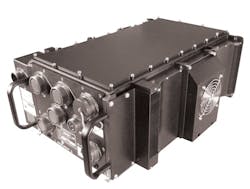Curtiss-Wright to provide avionics computer for Navy MQ-4C unmanned patrol plane in $7.5 million contract
PHILADELPHIA – Avionics computer experts at Curtiss-Wright Corp. will provide the U.S. Navy with an onboard advanced mission management system for the MQ-4C maritime patrol unmanned aerial vehicle (UAV) under terms of a $7.5 million sole-source contract announced Friday.
Officials of the U.S. Defense Logistics Agency's Aviation activity in Philadelphia are asking the Curtiss-Wright Defense Solutions division in Santa Clarita, Calif., to provide the mission management system for the Navy Northrop Grumman MQ-4C broad-area maritime surveillance (BAMS) UAV.
The Curtiss-Wright advanced mission management system (AMMS) provides the MQ-4C surveillance UAV with network-centric mission computer, data collection, and data correlation while incorporating support for Red/Black separation information security.
The AMMS has a new and improved high-speed interface embedded computing suite for high processing requirements, and a modular and scalable network-centric architecture, Curtiss-Wright officials say.
AMMS is an open-systems VPX-based system with internal volatile data storage, new DIO subsystem and discipline rubidium oscillator module, VPX-based embedded computing modules, and Gigabit Ethernet switches.
The MQ-4C Triton unmanned aircraft flies maritime surveillance missions as long as 24 hours at altitudes of more than 10 miles to enable coverage out to 2,000 nautical miles. The UAV's suite of sensors can detect and classify different types of ships automatically.
Curtiss-Wright won a $25 million contract from Northrop Grumman a decade ago to provide AMNS mission-management systems for the MQ-4C, and have been providing these kinds of avionics subsystems for the Triton UAV ever since.
The Triton is a crucial component of the Navy's 21st century strategy for conducting surveillance of surface ship and submarine traffic in the vast Pacific and other oceans around the globe. The Triton UAV will work together with the Navy's P-8A Poseidon manned maritime patrol aircraft.
The Triton's maritime search radar is called the Multi-Function Active Sensor (MFAS), and will provide the UAV and its operators with a 360-degree view of a large geographic area while providing all-weather coverage for detecting, classifying, tracking, and identifying points of interest. MFAS is separate from the Triton's air-to-air radar. The MFAS radar first flew on the Triton during testing in April 2015.
The MQ-4C Triton is provides combat information to military authorities like the expeditionary strike group, carrier strike group, and the joint forces maritime component commander. The Triton air vehicle is based on the U.S. Air Force RQ-4B Global Hawk, while its sensors are based on components and systems already fielded in the U.S. military.
The large unmanned aircraft provides intelligence for large ocean areas to maintain the common operational and tactical picture of the maritime battle space. The Triton feeds intelligence, surveillance, and reconnaissance (ISR) data to the Global Information Grid (GIG), and can work alone or together with other aircraft and surface ships.
The MQ-4C Triton's ability to perform persistent ISR within a practical range of 2,000 nautical miles enables the P-8A aircraft to focus on anti-surface ship warfare, anti-submarine warfare (ASW), and multi-intelligence. The Triton can fly as far as 8,200 nautical miles without refueling.
On this contract Curtiss-Wright will do the work in Santa Clarita, Calif., and should be finished by February 2022. For more information contact Curtiss-Wright Defense Solutions online at www.curtisswrightds.com, or the Defense Logistics Agency-Aviation at www.dla.mil.
About the Author
John Keller
Editor-in-Chief
John Keller is the Editor-in-Chief, Military & Aerospace Electronics Magazine--provides extensive coverage and analysis of enabling electronics and optoelectronic technologies in military, space and commercial aviation applications. John has been a member of the Military & Aerospace Electronics staff since 1989 and chief editor since 1995.

